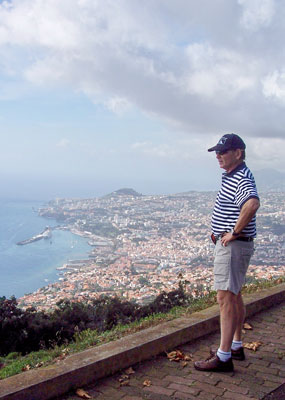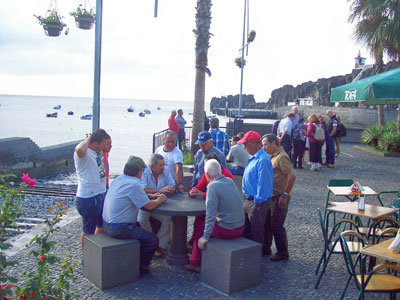Have some Madeira
This item appears on page 63 of the February 2014 issue.
(First of three parts)
For well over two decades I have felt drawn to the wondrous Portuguese isle of Madeira. Finally, in early November 2013, my wait was over. Over six blissful days, my wife, Gail, and I sampled some of the best of Madeira’s attractions on a visit that was partially hosted by Madeira Tourism (Funchal; phone 1 291 211 900, www.visitmadeira.pt [for English, click on “Idioma”]) and SATA airline (office in Fall River, MA; 508/677-0555).
Our journey to this idyllic, 57-by-22-kilometer Portuguese island lying some 470 nautical miles west of Casablanca, Morocco, was destined to exceed my expectations on virtually all fronts.
Ever-popular port of call
Settled around 1420-1425, Madeira is part of an Atlantic archipelago that was one of the first territorial discoveries in the exploratory period of the Portuguese Age of Discovery.
Christopher Columbus resided on the small, neighboring isle of Porto Santo for a short period until the death of his wife a decade prior to his New World discoveries. In the 16th century, Madeira became an important center for sugarcane production, followed in the 17th century by a shift in focus to producing wine. Madeira wines became the rage in Europe.
Over the centuries, the island maintained its status as a strategic stopover for both the east-west and north-south trade routes from Europe. Fast-forwarding to recent times, in 1976 the islanders were granted political autonomy by Portugal. Madeira has continued to evolve, maintaining a distinct island identity and cultural heritage.
Today Madeira’s economy is dependent primarily on tourism, with the island receiving over one million visitors annually, the majority from Europe. The island is an important stopover for commercial shipping vessels as well as for cruise ships operating between European ports, the Caribbean and North Africa.
Madeira superlatives
The only way I can justly portray Madeira in the space available for this 3-part article is to outline the multitude of superlatives that combine to make the island unique and so appealing to visitors.
First, the mountainous isle is visually spectacular, featuring scores of sheer cliffs that cascade to the sea in a plethora of dramatic settings. Throughout the island, man has conquered and then settled the steep slopes, carving out picturesque villages in seemingly impossible locations. Since land is at a premium, islanders waste none, building and planting crops on virtually every square meter of available land, little of which is level.
Madeira is not only a very safe place but is the cleanest destination I have ever visited, on a par with Singapore, and it boasts island-wide recycling. The island possesses an ultramild subtropical climate with minimal seasonal or daily temperature fluctuations, making it an appealing shirtsleeves destination for visitors year-round.
These mild temperatures and ample rainfall result in Madeira’s being a true botanical paradise, sporting a seemingly infinite number of both native and introduced species of flowers, shrubs and trees. Madeira is, in fact, famous for its many fine gardens, whose botanical offerings are among its primary attractions.
The climate also insures a lengthy growing season for the huge range of fruits and vegetables grown on the island, many of which were introduced centuries ago.
Annually on New Year’s Eve, Madeira hosts one of the world’s largest and most spectacular fireworks shows. Many cruise lines arrange itineraries so ships are present in Madeira Harbour for their passengers to witness the display.
Madeira is also a slice of heaven for those who enjoy festivals. The most popular are the 4-week-long Christmas and New Year celebrations (first week of December to first week of January), Carnival (late February to early March), the Madeira Flower Festival (held annually in spring, in 2014 on May 3-4), the Atlantic Festival (all of June) and the week-long Wine Festival (beginning either the last weekend in August or the first week of September).
Levada mania
Madeira’s intricate network of levadas (narrow man-made canals), with accompanying footpaths, wind their way more than 2,100 kilometers throughout the island. Islanders began developing the levada system in the 16th century to transport much-needed water from the mountains to the coastal villages and farms. Over the centuries levadas continued to be added, with the last one to be constructed completed in the 1940s.
The unique, fascinating labyrinth of winding levadas and footpaths results in an extensive system of exhilarating hiking trails, some interlinking, of varying lengths and levels of difficulty.
Many hikers, Europeans in particular, travel to Madeira, some repeatedly, specifically to undertake levada walks, which can be done either independently with careful planning or on a guided basis.
We chose to do the “Levada do Norte” walk, about eight kilometers, on a guided basis with Mountain Expedition (Funchal, phone +351 969 677 679), which also offers a range of island jeep tours.
I chose this particular levada route for Gail and myself because, although it was cut into the sides of steep slopes, it was, for the most part, flat. It featured views of the sea and and passed through small hillside farming plots, providing the opportunity to experience firsthand how the locals live while tending their mostly terraced crops.
During our hike, one kind lady even offered us apples from her tree when we stopped to admire her small hillside home.
As a bonus, our guide, Osvaldo Ramos, was a veritable fount of knowledge on seemingly all subjects related to Madeira. I strongly recommend levada walks for those who are physically able, although they should be clear about the level of difficulty for any walk they’re considering.
Next month I will report on more of the northern and western parts of Madeira as well as about our exploration, on foot, of the capital, Funchal, and about some of Funchal’s enticing gardens.
Beyond the Garden Wall
Compare not this tiny symbiotic bouquet
of man in concert with his natural world surrounds,
Madeira is too uniquely Madeira
— Randy sharing his Madeira rapture



